Saboteur: A quick, fun card game with secretly assigned teams
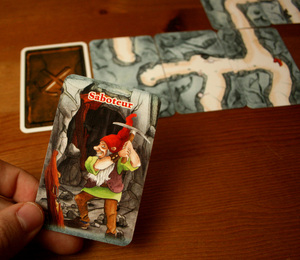
Mike Hulsebus | Contributor
I’ve recently been on the lookout for games that allow players to play on teams rather than an every-player-for-himself game or fully cooperative games. Saboteur is a game that pits a crew of gold-digging dwarves against the Saboteurs among them that would seek to sabotage their progress and take the gold for themselves. While one team tries to push forward, the saboteurs hide their true nature until the perfect moment arises to cause a rock slide, blocking the path to victory.
Let’s take a look at how the game plays to determine whether Saboteur is a dynamite experience or a few nuggets short of a full load.
At the start of each round of Saboteur, each player will get a hidden role card, telling them whether they are a good dwarf looking to help the team or whether they are a saboteur, looking to prevent the good dwarves from finding the gold.
The start card is placed, and then three different goal cards are placed seven card-lengths away. One of these hides the gold nugget, the others are decoys. On a player’s turn, one card that he might play — if he is a good dwarf — is a path card that gets the mining team closer to the goal.
If he thinks that he has identified which player is the saboteur, he might try to hinder that player from causing too much trouble. The player could play a broken tool on that player which would, until he was able to get a fixed tool card, prevent him from adding any path cards to the mine.
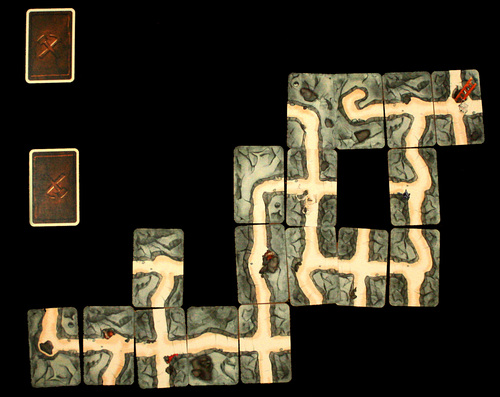
In the pictured instance, the dwarves have connected to the lower goal card only to find that it didn't have the gold. They will continue on from there to try to reach the goal card that has the gold.
Mike Hulsebus | Contributor
I know what you’re thinking: isn’t it going to be obvious who the Saboteurs are? Isn’t he always the one who is playing the dead end path cards and causing problems? Yes and no. Some of the more important cards in the deck are the map cards. The map card allows a player to look at one of the three goal cards. So say that you and I are playing, and I look at a goal card. Then, on my next turn, I block all of our progress toward that card. I may have done that because I am a Saboteur and saw that it was the gold. Or, on the other hand, did I do that because I am a good dwarf, and I don’t want us to waste any cards going toward a card that isn’t our goal?
The good dwarves must manage their resources; there are a finite amount of cards that allow you to get closer to your goal. While there are a lot of path cards in the deck, not all of them travel horizontally — the direction you’ll need to mine to reach the treasure. If the good dwarves waste too many cards going nowhere, they won’t be able to win, and the saboteurs will win instead.
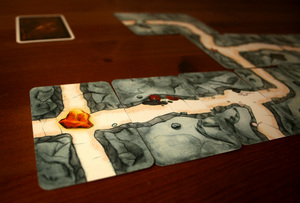
Mike Hulsebus | Contributor
If the good dwarves do make it to the gold, they win that round and score points. They lose if they go through the entire deck without making it to the treasure. Players play three rounds (receiving new roles each time), and whoever has the most money at the end, wins.
There is a lot to like about this game. I like that this is a quick-to-learn hidden role game (unlike, say, Bang). Furthermore, an interesting thing about how roles are distributed is that there is always one role that isn’t used. For example, in the five-player game, you take six role cards (four good dwarves, two saboteurs) and each player gets one, leaving one unassigned. This leaves players to wonder whether there are one or two saboteurs in their midst.
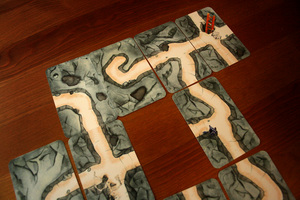
Mike Hulsebus | Contributor
The main thing that I don’t really like about the game is the scoring. When the good players win, you deal out a number of gold nuggets card equal to the number of total players) and then you start with whoever played the winning card and pass them around to the good players, everyone taking one until they’re all gone. So, since we skip the Saboteurs, this means that whoever played the final mine card always gets two nuggets. While I’m not a fan of this, I suspect that there are other people that love this rule since it encourages more in-fighting among the dwarves and further obscures who the saboteurs are.
I guess really, my problem with the game is that it doesn’t feel like the final scoring matches up with who did the best in the game. Since gold nugget cards can have one to three gold nuggets on them, a player could easily lose not because he didn’t play cleverly enough, but because he just got the unlucky draws on nugget cards. I don’t have a problem with other random elements of the game, but for some reason, this bothers me. To me, it feels like if you were to play Sorry and have each pawn that reaches home be randomly worth one to six points. I would rather see a flat reward for winning a round than to have that variability.
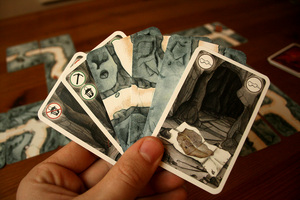
Pictured in the front of this hand of cards, the ever-important map card allows a player information as to which goal card has the gold under it.
Mike Hulsebus | Contributor
Still, I recognize that a quick card game has to have some degree of luck-of-the-draw to it, and, scoring problems aside, the game itself is a really fun game. While I play Saboteur seeking to win, the fun part of the game is playing it, regardless of who wins. Even if I’m not the overall victor of the game, there is still satisfaction of winning a round of the game and getting to pass around the treasure that we’ve earned as a team.
What makes the game exciting is not knowing who to trust and figuring out over the course of the game who is on your side. Yes, those two players each mapped out that goal card, but should you trust the person that blocked it off or the person that is trying to connect it? Who is on your team and who is trying to get you to harm your own teammates?
Saboteur is a good game because it is a lot of fun for the amount of time that it takes, is easy to teach, supports a wide range of players (3-10), and has enough going on to differentiate it from other types of card games.
Yes, sometimes your plans won’t work out and sometimes a team will win based solely on lucky breaks. And yes, sometimes you might be unable to get rid of a broken tool turn after turn after turn. But the game is fun to play. If you pick this up looking for a fun card game that plays a good number of players, you’re going to be satisfied. If you’re looking for something with a lot of strategic depth, go buy a more serious game (like BSG if you have two or three hours). Whether I’m going to play games with nerds or non-nerds, I expect that I’ll be bringing Saboteur with me just about every time.
Mike Hulsebus wants to steal the Right of Way card from his Mille Bornes set and play it to fly right through to the gold. He can be reached at mikehulsebus@gmail.com

